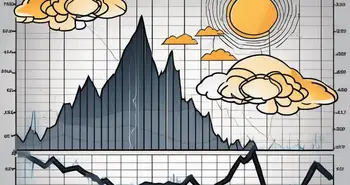The Code of Market Anomalies: Insider Tips for Traders

In the dynamic world of finance, market anomalies play a crucial role in shaping investment strategies. These puzzling phenomena can hold the key to unlocking hidden opportunities or, conversely, pose significant risks. As an expert in the field, I have delved deep into the intricacies of market anomalies, their causes, identification techniques, and the impact they have on investment decisions. Join me as we explore this comprehensive guide to uncovering market anomalies and revolutionize your investment approach.
Understanding Market Anomalies
Market anomalies are intriguing deviations from the efficient market hypothesis, challenging the notion that stock prices fully reflect all available information. To grasp the concept, it's essential to comprehend their definition and various types. Market anomalies can manifest as price discrepancies, abnormal returns, or statistical oddities that persist over time. They can be classified into three main categories:
Definition and Types of Market Anomalies
The first type is the price anomaly, where the market price significantly deviates from the intrinsic value of an asset. These anomalies often arise due to investor sentiment or market inefficiencies.
For example, during periods of market exuberance, investor sentiment can drive prices far beyond the fundamental value of an asset. This can result in a price anomaly where the market price becomes disconnected from the underlying value, creating opportunities for astute investors to capitalize on the mispricing.
The second type is the event anomaly, triggered by unexpected news or events influencing market behavior. Sudden shifts in supply and demand can create temporary disruptions, leading to abnormal returns.
Consider a scenario where a company announces a breakthrough innovation that revolutionizes an industry. This unexpected news can trigger an event anomaly, causing a surge in the company's stock price as investors rush to capitalize on the potential future growth. Such anomalies provide opportunities for traders to profit from short-term market inefficiencies.
The third and final type is the statistical anomaly, which focuses on identifying patterns in historical price data. These patterns reveal irregularities that can be leveraged for profitable trades.
One example of a statistical anomaly is the “January effect.” Historically, stock prices tend to experience a surge in January, possibly due to tax considerations or year-end portfolio adjustments. This recurring pattern presents an opportunity for investors to buy stocks in December and sell them in January, capitalizing on the statistical anomaly.
The Role of Market Anomalies in Finance
Market anomalies act as windows into the underlying dynamics of financial markets. By observing and understanding these irregularities, financial professionals can gain insights into investor behavior, market inefficiencies, and information asymmetry.
For instance, the presence of price anomalies can indicate market inefficiencies, suggesting that not all available information is being fully incorporated into stock prices. This challenges the efficient market hypothesis and prompts researchers to explore the factors contributing to these anomalies.
Furthermore, market anomalies challenge the efficient market hypothesis and raise questions about the rationality of market participants. Studying anomalies can help analysts better understand the limits of traditional finance theories and explore alternative approaches.
By delving into the world of market anomalies, financial professionals can uncover valuable insights that can inform investment strategies, risk management techniques, and the development of new financial models. The study of market anomalies is an ongoing endeavor, as financial markets continue to evolve and present new challenges and opportunities for those who dare to explore beyond the conventional wisdom.
The Causes of Market Anomalies
Market anomalies have diverse root causes, blending behavioral and economic factors. By examining these causes, we can gain a deeper understanding of their origins and implications for investment decisions.
Behavioral Finance and Market Anomalies
Behavioral finance plays a significant role in the occurrence of market anomalies. Investor biases, such as overconfidence, herding behavior, and loss aversion, can distort asset prices and create opportunities for astute investors.
For instance, the disposition effect, where investors tend to hold on to losing positions longer than winning ones, can lead to mispricing and potential profit opportunities for those who can identify and exploit it.
Understanding the psychological factors at play allows investors to navigate the market landscape better and capitalize on behavioral inefficiencies.
Economic Factors Influencing Market Anomalies
Besides behavioral aspects, economic factors also contribute to the emergence of market anomalies. Events such as recessions, changes in monetary policy, or fluctuations in commodity prices can disrupt market equilibrium, creating windows of opportunity.
Investors who can accurately identify and assess such economic drivers stand to benefit from the resulting anomalies. By analyzing macroeconomic data and staying abreast of market trends, astute professionals can make informed investment decisions.
Identifying Market Anomalies
Identifying market anomalies requires a comprehensive toolkit of tools and techniques. By employing these methods, investors can pinpoint irregularities and seize opportunities as they arise.
Tools and Techniques for Detection
One effective approach for detecting market anomalies is trend analysis. By studying long-term price patterns and identifying recurring irregularities, investors can make informed decisions based on historical data.
Another popular technique is statistical arbitrage, where investors exploit temporary price discrepancies between correlated instruments. This strategy relies on complex mathematical models and real-time data analysis.
Additionally, sentiment analysis, which involves gauging investor sentiment through social media and news sentiment, can offer valuable insights into potential market anomalies.
The Role of Data Analysis in Uncovering Anomalies
Data analysis is a crucial component in the detection of market anomalies. By leveraging robust data sets and utilizing sophisticated analytical tools, investors can uncover hidden patterns and relationships.
Big data and machine learning techniques allow analysts to process vast volumes of data and elucidate complex market dynamics. This data-driven approach enhances the accuracy and timeliness of anomaly detection, enabling investors to act decisively.
The Impact of Market Anomalies on Investment Strategies
Market anomalies have a profound impact on investment strategies. To remain competitive and adapt to changing market dynamics, investors must understand how to integrate these anomalies into their decision-making process.
Adjusting Investment Approaches in Light of Anomalies
When market anomalies are detected, it is essential for investors to adjust their investment approaches accordingly. Anomalies can signal mispriced securities or trends that can be exploited for profit.
By incorporating anomaly-based strategies, investors can leverage opportunities that arise from market inefficiencies and generate superior risk-adjusted returns.
Risk Management and Market Anomalies
Despite the potential benefits, market anomalies also carry inherent risks. Unanticipated shifts in market dynamics or failed anomaly detection can lead to financial losses.
Implementing robust risk management practices and diversifying portfolios can mitigate the impact of anomalies. By spreading investments across different asset classes and employing sound risk mitigation strategies, investors can safeguard their portfolios.
Mitigating the Effects of Market Anomalies
Mitigating the effects of market anomalies involves proactive strategies aimed at minimizing risks and maximizing returns. Investors can employ a range of techniques to navigate the complex landscape of market irregularities.
Strategies for Reducing Anomaly Impact
One effective approach is to diversify portfolios across uncorrelated assets, reducing exposure to specific anomalies or market sectors. By spreading investments, investors can cushion the impact of abnormal returns arising from individual anomalies.
Additionally, employing robust risk management practices, such as stop-loss orders and position sizing, can limit potential losses when anomaly-driven trades turn unfavorable.
Furthermore, staying informed and continuously monitoring the market landscape allows investors to adapt quickly to changing market conditions and mitigate the potential effects of market anomalies.
The Role of Regulatory Bodies in Controlling Anomalies
Regulatory bodies play a vital role in maintaining market integrity and controlling anomalies. These organizations enforce rules and regulations aimed at ensuring fair and transparent markets.
Investors should stay abreast of regulatory developments and comply with relevant guidelines. By engaging in responsible and ethical investing practices, investors can contribute to the overall stability and fairness of financial markets.
Throughout my career, I have witnessed firsthand the transformative power of understanding and leveraging market anomalies. By embracing a data-driven approach, embracing innovative strategies, and remaining agile, investors can unlock new realms of opportunity.
Remember, in the world of finance, knowledge is power. Stay curious, be vigilant, and explore the untapped potential of market anomalies.
FAQ
What are market anomalies?
Market anomalies are deviations from the efficient market hypothesis, where stock prices deviate from their intrinsic values. They can manifest as price discrepancies, abnormal returns, or statistical patterns that persist over time.
How can market anomalies be identified?
Market anomalies can be identified through a combination of tools and techniques. Trend analysis, statistical arbitrage, and sentiment analysis are among the most commonly used methods. Additionally, leveraging data analysis and employing advanced analytical tools can enhance anomaly detection.
What is the impact of market anomalies on investment strategies?
Market anomalies have a profound impact on investment strategies. They can offer opportunities to generate superior returns, but also carry inherent risks. It is essential for investors to adjust their investment approaches accordingly and implement robust risk management practices.
How can the effects of market anomalies be mitigated?
The effects of market anomalies can be mitigated through various strategies. Diversification, risk management practices, and staying informed about market developments are key. Additionally, compliance with regulatory guidelines ensures responsible and ethical investing practices.
Why is understanding market anomalies important?
Understanding market anomalies is crucial for investors seeking a competitive edge. It allows for the identification of mispriced securities and trends that can be leveraged for profit. Moreover, studying market anomalies challenges traditional finance theories, fostering innovation and alternative approaches to investing.
Ready to put your knowledge of market anomalies to the test and gain a competitive edge in your investments? Look no further than Morpher, the revolutionary trading platform that's changing the game with blockchain technology. With Morpher, you can trade a multitude of asset classes, from stocks and cryptocurrencies to unique markets, all with zero fees, infinite liquidity, and the safety of a non-custodial wallet. Whether you're looking to invest fractionally, short sell without interest fees, or leverage your trades up to 10x, Morpher offers a unique and flexible trading experience. Sign Up and Get Your Free Sign Up Bonus today to start trading the future of finance.

Disclaimer: All investments involve risk, and the past performance of a security, industry, sector, market, financial product, trading strategy, or individual’s trading does not guarantee future results or returns. Investors are fully responsible for any investment decisions they make. Such decisions should be based solely on an evaluation of their financial circumstances, investment objectives, risk tolerance, and liquidity needs. This post does not constitute investment advice.

Painless trading for everyone
Hundreds of markets all in one place - Apple, Bitcoin, Gold, Watches, NFTs, Sneakers and so much more.

Painless trading for everyone
Hundreds of markets all in one place - Apple, Bitcoin, Gold, Watches, NFTs, Sneakers and so much more.









